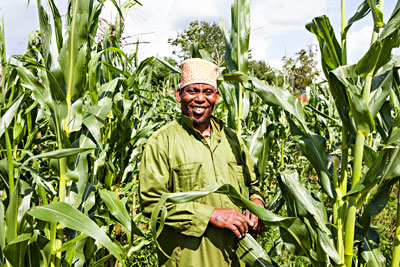 |
| New American Sustainable Agriculture Project graduate Jabril Abdi pauses in his corn field. |
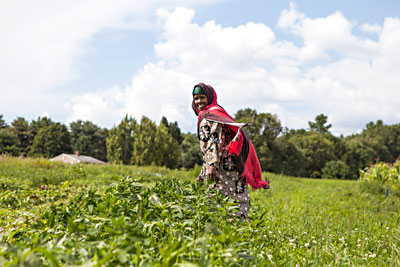 |
| Batula Ismail farms her plot in Lisbon. |
By Stowell P. Watters
Photos by Greta Rybus
Here is a nightmare we Mainers can only imagine: A group of men with assault rifles comes barreling across the savannah to demand that we part with everything we own. Right there, on the spot, guns loaded, everything.
Here is a truth we are only minutely aware of as a society: For those caught in Somalia’s civil wars, this is a common nightmare, a tape that has been rewound and played back countless times since 1991, when the entire region was fractured.
Right now Somalia is beset by one of the worst humanitarian crises our Earth has ever seen. The United Nations Refugee Agency (UNRA) estimates that more than 2 million Somalis and Somali Bantus have been displaced by drought and violence, forced to seek refuge in foreign lands such as neighboring Kenya, or faraway Atlanta, Georgia. In 2012, the new president, Hassan Sheikh Mohamoud, was elected and, backed by support from Westerners, has maintained control over the weakened government centered in the capital of Mogadishu. But violence, famine and unrest continue. Discrimination continues.
Somalia wraps around the horn of Africa. The northern region of the country is a savannah, peppered by huge acacia trees and tough grass. It is inhabited primarily by ethnic Somalis who spend their lives as nomads, herding their flocks of sheep, goats, cattle and camels in seasonal odysseys to find water and grass. The soil is sandy and the average annual rainfall usually comes in at about 3 inches.
The southern region has fertile flood plains where two enormous rivers course down from the Ethiopian highlands. In this region, known as the Juba Valley, growing seasons are marked by the flooding of the Juba and the Shabelle rivers, which move farmers from field to field, harvesting one crop just before the waters come to carry away the weeds and the duff.
In this way the soil remains healthy enough to sprout lush vegetation and support a population of people and large animals such as elephants and hippopotami. Working in these fields are the Somali Bantu people.
The Somali Bantu are farmers; they do not move about like the ethnic Somalian peoples. Instead they stay near the rivers and grow food for subsistence and trade. Their physical appearance is different as well – their hair is wirier and they are squat and more muscular than the ethnic Somalis.
The Bantu are different because they are mostly descendants of slaves taken in the 1800s from southern Africa as part of the massive Arab slave trade. Sold from the city of Zanzibar to plantation owners in Somalia, some 50,000 Africans gave way to today’s population of Somali Bantus, now an estimated 1 million.
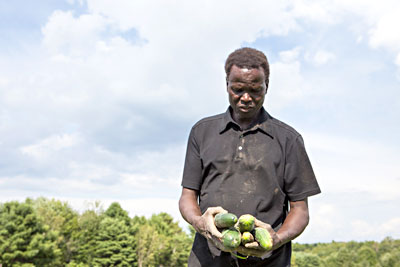 |
| John Yanga, a NASAP graduate, now operates his own farm in Lisbon. |
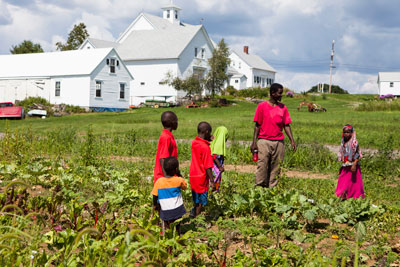 |
| Hussein Muktar farms with his family. |
The Bantu are regarded by their fellow Somalis as lower class; fit only for manual labor. Farming is viewed by ethnic Somalis as menial. In 2003 the United States gave the Bantu a separate designation from the ethnic Somalis and opened its doors to 12,000 Somali Bantu people following decades of discrimination, theft, murder and abuse.
Refugees do not just leave their homes; they flee from them. Met with insurmountable challenges, such as finding food and safety, the Somali Bantu people report to refugee camps and are then resettled in huge cities such as Sacramento, Atlanta, Memphis or Kansas City. From a lush country of wide open spaces and free roaming animals to some of our most populated cities, refugees are plunked down among a populace in busy flux; cars and concrete spreading out in all directions, towering buildings, fast food and cell phones.
From the big cities the Bantu can move freely, often choosing a secondary home in a smaller city where the rigors of metropolitan life are lessened. One such resettlement location is the Maine city of Lewiston, on the Androscoggin River.
Lewiston is no stranger to people from foreign lands. In the 1870s, together with the perennial partner city of Auburn and backed by booming mills along the river, Lewiston built a railroad spur that connected the cities to the Grand Trunk Railway line coming from Montreal to Portland. Thousands of French Canadians flocked to the area and settled along the river. So many that, according to historian Douglas Hodgkin, the area between Lisbon Street and the river became known as “Little Canada.”
Today, nearly 4,000 Somalis live in the cities of Lewiston and Auburn, a metropolitan area with a robust population of nearly 60,000. Lewiston has a low crime rate and affordable housing – two benefits that appeal to the Somali Bantu people. They still experience congested streets, large housing complexes, massive box retail stores and fast food – but it is a far cry from Atlanta.
Somali Bantus also come to Maine because here, they can farm again.
“It gives them encouragement and strength. You can see it in their faces; they have a very strong connection to the land.”
These are the words of Daniel Ungier, director of farmer training at Portland-based Cultivating Community. He heads the New American Sustainable Agriculture Project (NASAP), which puts refugees from all over the planet onto plots of land around Maine so that they can grow, market and sell their own produce. As of now, three-quarters of their New American Farmers are Somali Bantu.
While NASAP has been operating since 2006, Ungier says the project really took off in 2009, when it came to an agreement with the Packard Littlefield Farm in Lisbon to lease 18 acres of farmland. In addition, NASAP has about an acre cultivated in both South Portland and Cape Elizabeth.
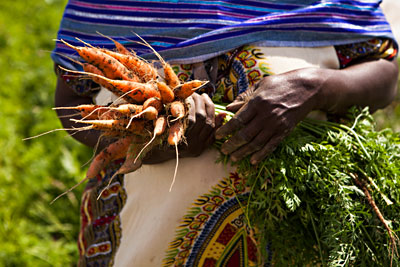 |
| New American Farmers grow everything from carrots to molokia. |
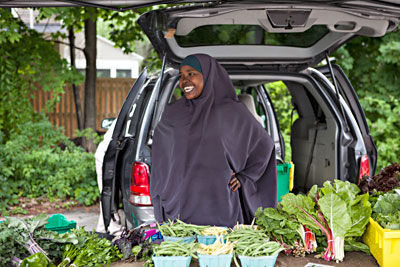 |
| Asli Hassan sells produce for Fresh Start Farms. |
It works like this: Refugees first enroll in the NASAP program and take classes in Lewiston and Portland on everything from managing planting schedules to selling vegetables at farmers’ markets. They know how to farm, but in Maine they must learn how to deal with not only a single growing season, but also the great impetus of our agricultural hibernation – frost.
As current New American Farmer Seynab Ali says, growing here in Maine is, well, “different. I love it, but it is different, harder in some ways, easier in some ways,” she says. “I don’t like the cold; no one likes the cold.”
Seynab Ali wears a bright wrap and hoes her rows of arugula, doting on bits of purslane popping up in the Lisbon soil. Around her other refugees tend their plots, all responsible for their own small farm operation and subsequent contribution to the NASAP wholesale and market program – called Fresh Start Farms.
She speaks about the Bantu harvests and stops hoeing to sweep her arm across the field. In her homeland, the harvests are all hands on deck, done by dozens of workers in preparation for the floods that sweep across the region.
“We don’t do this,” she says, referring to snipping small portions of arugula for salad mix to sell at the farmers’ market. She then waves across the horizon. “We do all of this,” that is, harvest large amounts of crops from whole fields.
Where she comes from the food is spicy, or, in her words, “spicy spicy.” The Somali Bantu eat lots of corn and beans, paired with hot peppers and spiced with garlic, cardamom, ginger, curry and chili powder. They eat sambusas (pastries with savory fillings) as well as avocados and okra and mangoes. They cook with an Egyptian spinach called molokia. They eat beef and chicken and goat and camel, and they speak about a type of small sweet pumpkin from their homeland that has stumped everyone working for the NASAP program.
“Yeah, that pumpkin, we don’t know what it is, can’t find it, but we did take a group up to Fedco last year to do the seed order,” says Ungier, who helped truck a dozen farmers to the seed company’s retail warehouse in Clinton, Maine. Choosing seeds and budgeting their purchase is a huge part of the education the New American Farmers receive.
Currently the program has 30 farmers in various stages of training. They are given their own plot to grow on, either in Lisbon, Portland or Cape Elizabeth, and sell the food through five urban farm stands, including the Portland Farmers’ Market. Fresh Start Farms also offers a CSA, stocked by the farmers in training, and participates in a dozen other markets in towns such as Damariscotta, Norway and Kennebunk. They even have a mobile farm stand in Portland where vegetables can be purchased off the back of a bicycle-pulled cart.
The goal, according to Ungier, is for the farmers to use the program for five years and work up to where they can earn about $20,000 on their own bit of land. Once they graduate, participants can acquire their own leases and farm names – all with NASAP assistance.
The Somalis have their own language, and many of the Bantu people speak it, but some also speak regional dialects dating back to their ancestral homes in southern Africa. This makes for a tricky situation; in order to educate the refugees, NASAP had to first find a way simply to communicate with them.
In 2008 they found their answer – the energetic Hussein Muktar. Muktar started as a new farmer but quickly became relied on for his skills as an interpreter. He was soon employed by Cultivating Community as NASAP’s outreach coordinator because he speaks fluent English as well as Somali and two dialects, Mai-Mai and Af Maha.
Muktar is a young father of five and an avid farmer. One minute he is turning a wrench on the back of the tractor, the next he is picking up a pair of shoes his kids left in the field. Two minutes later he appears in a packing shed, elbow deep in a carrot water-bath.
“I just love it; I want to farm my whole life,” Muktar says.
This sentiment is shared not only by the farmers in training but apparently by Black and African American farmers all across Maine. The United States Department of Agriculture’s 2007-2012 Agriculture Census says that Black- and African American-operated farms increased here by 400 percent (from 17 to 68), while the number of farms operated by white Americans grew by only half a percent (a net gain of four new farms). Of course this takes into account the many retiring farmers; still, if not for the net increase in Black- and African American-operated farms, our state would have seen a reduction in the total number of operating farms.
Farming allows Muktar to care for his family while generating an income. This is hugely important to the refugees, as it means they can go to work without worrying about where their families will stay in the cities where they live. The other benefit, according to Seynab Ali, is the food.
“My son, he comes over and he says he can’t smell the food in America,” she says. “But when I cook for him, he can smell the food.”
Being able to grow the comfort foods of her homeland means everything to her. It provides her with a direct connection to the place and the land where she was born and raised. It feeds her family.
She has a cellphone now and uses it to talk to her family. She drives a minivan, too, helping to bus the farmers from Lewiston to Lisbon. Some of her memories sound more like nightmares, so connecting to them through farming seems like the last thing she would want to do. But that would be making the assumption that she connects the trauma of the Somalian civil wars with her life as a farmer.
She does not; they do not. For the refugees, farming the fields in Lisbon isn’t about wrack and ruin and escape – you can’t spot any of that in their faces. All you can see are smiles, great big smiles, and hands happy to do the work of New American Farmers.
About the author: Stowell Watters is a MOFGA journeyperson at his farm in Limington.
